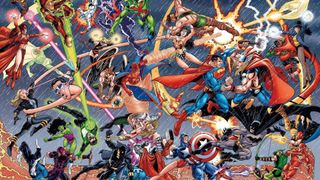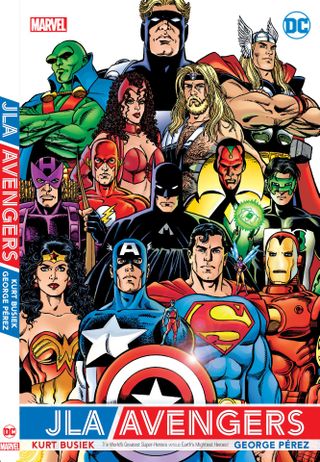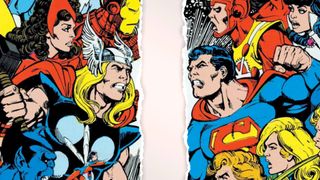Next week will mark an unusual occurrence for mainstream comic books in the 21st century - two significant characters from different high-profile publishers will cross over.
We're talking about Batman/Spawn, December 13's new one-shot special from DC featuring the Dark Knight and Todd McFarlane's signature Image Comics creation.
And if you're a fan of such a thing, you might want to savor it, as major inter-company crossovers will likely continue to be very unusual in this day and age, and with the odds of a new Marvel and DC crossover being effectively zero.
In fact, the former rivals barely acknowledge one another's existence anymore, much less show any inclination to work together on anything new.
Sure, there was a brief and very limited reprieve in February of this past year due to an extraordinary circumstance, but what was once a storied, high-profile, sometimes-good-natured/sometimes-not rivalry is for all intents and purposes kaput … history ... an anachronistic remnant of a now bygone comic book era.
You know the terms - the 'Distinguished Competition' (Marvel's coded term for DC) … 'Crosstown Rivals' (when they were actually across town from one another in New York City) … and the 'Big Two' (denoting their dominant market position among publishers that serve dedicated comic book stores called the Direct Market).

For decades Marvel and DC were the Coke and Pepsi … the McDonald's and Burger King … the Yankees and Red Sox of superhero publishers. And like those other three traditional rivalries, one party more or less dominated the other for most of the history between them - in this case, Marvel.
While there have been a few years in which DC sales have eclipsed Marvel sales or kept the horserace close, Marvel has been the market leader consistently, at least in sales to comic book shops.
And despite having a head start with iconic successes like the George Reeve Superman and Adam West TV shows, the Super Friends Saturday morning cartoon, and Christopher Reeves Superman and Michael Keaton Batman film franchises, Marvel has also come to dominate DC in terms of media adaptations of its properties in the 21st century. But that's a subject for another day.
The point is even if by sales the rivalry has been lopsided, DC is still the publisher of the iconic Wonder Woman, Batman, Superman, and Justice League, and what that rivalry with Spider-Man, the Hulk, the X-Men, and the Avengers means to fans helped create something memorable … something fun … something special.
And it wasn't just comic book shop (and then message board and then social media) talk about who had the better or stronger heroes or villains. The publishers themselves engaged in the rivalry … egged it on … which of course set things up for huge sales successes like 1996's DC versus Marvel and its companion Amalgam and 2003-2004's JLA/Avengers by Kurt Busiek and George Pérez when they could find their way to working with one another.

It was appointment comic book reading even for jaded fans, and in the case of Marvel versus DC (yes, the publishers traded turns whose name went first) and Amalgam, it came at a tenuous and much-needed time for the medium.
DC and Marvel even got so good at working together they even seriously contemplated swapping two characters for one another before the legal implications became too much to overcome.
And even when things got testy, the chemistry it created was additive … a net positive for the seemingly perpetually struggling Direct Market.
But that dynamic is no more and despite the faint pulse it seemed like it had this past spring when the two publishers cooperated with the help of the comic book charity the Hero Initiative to reprint 7000 copies of JLA/Avengers, the relationship is likely to stay that dormant for the foreseeable future.
JLA/Avengers was an extraordinary circumstance. I hesitate to use the common term about three large storms converging because there is nothing resembling 'perfect' about it.

George Pérez, a giant of the industry who also happened to be a giant of a human being, disclosed a terminal cancer diagnosis just weeks before, stating his doctors advised him he only had months left to live, which ultimately turned out to be tragically accurate. Pérez announced his fate to the comic book community with such grace and generosity of spirit, it would have been difficult for Marvel and DC to not reprint JLA/Avengers when such a gesture seemed so obvious from the start.
But that isn't to take away from the fact they did, which was almost certainly complicated.
Now I'm not going to get into the limited print run, another complicated circumstance that shouldn't supersede the fact Pérez's extraordinary announcement might have been the only one that could have broken the DC-Marvel silence in the limited way it did, and perhaps more amazingly as quickly as it did.
But the exceptions prove the rule and as welcome as the JLA/Avengers news was, it only contrasts with the recent history all the more and at the same time highlighted how even while they were working together for a worthy endeavor, the lack of any coordinated public messaging between them over the reprint was stark.
The silence was deafening
The lack of anything resembling Marvel and DC's historical back and forth and the absence of the good their combined power has the potential to do was particularly conspicuous in the middle of 2020. The Direct Market was existentially threatened by the social distancing measures that dictated the closing of brick-and-mortar comic book shops and likely led to the dethroning of the once-dominant industry distributor Diamond.
But while Marvel and DC individually took notice, there was no hint of a joint response to crises or even reasons to think the thought occurred to either side.
In past decades, it might have been an opportunity for the two most powerful industry presences to find a way to work together to create a unique, unparalleled publishing event to help boost the fortunes of struggling retailers, but no such effort emerged (hey, we tried!)
In fact, the market has evolved so that there is little to anything tying the publishers together in any practical way at all making it difficult for even fans to keep a spark of a rivalry alive.
Most of the crossovers are decades old and out of print and as mentioned, even JLA/Avengers only saw 7000 new copies hit the market and there's no indication of any plans to expand on it for another printing. And let's also take a second to recognize while Marvel participated in releasing the JLA/Avengers news to the comic book press, the publisher was more or less publicly silent about their participation.
As to other x-factors...
Marvel and DC don't vie for the attention of the same distributor anymore. And any banter, friendly or pointed, has all but disappeared, a byproduct of the low PR profile and lack of public dialogue adopted by both publishers to varying degrees in recent years.
Why was the firewall between Marvel and DC built?
There are a few specific reasons, including geography, the now-lack of a centralized print distributor serving both publishers, the still-compromised state of the in-person comic book convention in which both publishers participate and compete for attention, and the practical implications of both publishers being owned by corporate giants and serving as some of their respective parent company's most valuable intellectual property farms.
But most of all both publishers simply no longer have public spokespeople engaging in just about any (much less spontaneous) public dialogue other than carefully planned and approved promotion of specific comic books and characters.
In 2022 when a badly-worded tweet can cause an immediate backlash, Marvel and DC have seemingly made the decision that they'll rarely risk having an executive, editor, or marketing spokesperson making anything that could even be considered a wave. They have also seemingly asked creators to mostly refrain from doing the same.
The DC-Marvel rivalry simply can't exist in a vacuum, and there doesn't seem to be any prospect of the seal being broken anytime soon for any other reason but to honor a legend due to his passing.
We'll get deeper into the reasons why another time, and for while we could feel good about JLA/Avengers and hold out hope that the project might get the emails or phone calls flowing from New York City to Burbank again, but it doesn't appear to be the case.
Maybe sales of December's Batman/Spawn will get the publishers rethinking if the pitfalls and complications are worth a new Spider-Man-Batman crossover.
Although 'probably not' is the likey answer.
How artist George Pérez drew the entire Marvel and DC Universes and redefined the superhero genre.

